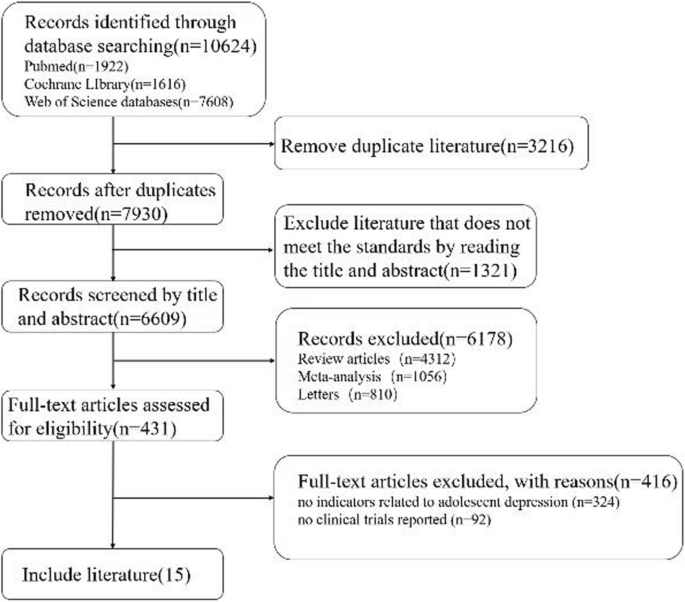Efficacy of Antidepressant Medications for Adolescent Depression: A Systematic Review and Network Meta-Analysis


Literature Review and Evaluation Procedure
In conducting a thorough examination of the literature surrounding adolescent depression and its pharmacological treatments, a comprehensive search yielded a total of 10,624 preliminary research articles. Notably, 1,922 articles were sourced from PubMed, 1,622 from the Cochrane Library, and a substantial 7,608 from Web of Science. Rigorous data management protocols necessitated the elimination of 3,216 duplicate articles, leading to a subsequent review of titles and abstracts. Ultimately, 431 articles met predetermined inclusion criteria for further evaluation, leading to a detailed investigation into seven medications used for treating adolescent depression: fluoxetine, vilazodone, paroxetine, escitalopram, sertraline, venlafaxine, agomelatine, and a placebo comparator. As a result, the analysis encompassed a total of eight distinct interventions. The methodology for literature screening is presented in Flow Chart 1, which outlines the comprehensive review process employed.
Fundamental Attributes and Assessment of Methodological Rigor
The refined set of fifteen articles selected for the network meta-analysis (NMA) incorporated a collective sample of 12,258 study participants. The studies collectively explored the efficacy of the aforementioned seven medications, as well as a placebo, thereby covering a wide range of adolescent depression treatments. Key characteristics of the studies included in the analysis are detailed in Table 1, while Figures 2A and 2B provide insights into the methodological rigor demonstrated across the included studies.
Outcomes of the Network Meta-Analysis
This investigation into the treatment options for adolescent depression revealed a multi-faceted approach, encompassing eight interventions: fluoxetine, vilazodone, paroxetine, escitalopram, sertraline, venlafaxine, agomelatine, and placebo. The evidence relationship diagram clarifying the connections between these interventions is illustrated in Figure 3, with specific figures depicting network structures for various clinical outcomes.
Changes in CDRS-R Scores
Evident from the data obtained from 13 randomized controlled trials (RCTs) involving 3,503 subjects, the mean changes in CDRS-R scores underscore variations in the intensity of depressive symptoms. Notable reductions in scores following treatment were observed for agomelatine (mean difference [MD] of −0.34) and fluoxetine (MD of −0.31) in comparison to the placebo group, among others. The overall analysis of the treatment effects based on the SUCRA curve indicated that agomelatine and fluoxetine exhibited potential advantages in ameliorating depressive symptoms in adolescents.
Changes in CGI-S Scores
Furthermore, an analysis of CGI-S scores, derived from seven RCTs with 2,220 participants, demonstrated that sertraline, escitalopram, fluoxetine, and others significantly improved CGI-S scores compared to placebo, highlighting sertraline as a particularly effective treatment option.
Conclusion and Implications
The findings of this review provide critical insights into the efficacy of various pharmacological interventions for treating adolescent depression. With emerging evidence favoring certain medications, there is a pressing need for clinicians to consider these findings when prescribing treatments. Overall, this synthesis of literature not only contributes to our understanding of effective therapeutic options but also underscores the importance of continuous research in the evolving landscape of mental health treatment for adolescents.
In light of potential publication bias illustrated in the funnel plot, further investigation and transparency in research practices are essential for advancing knowledge and ensuring the integrity of clinical findings in adolescent depression therapy.





